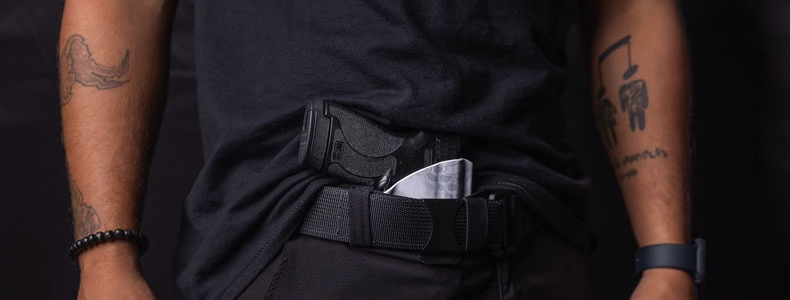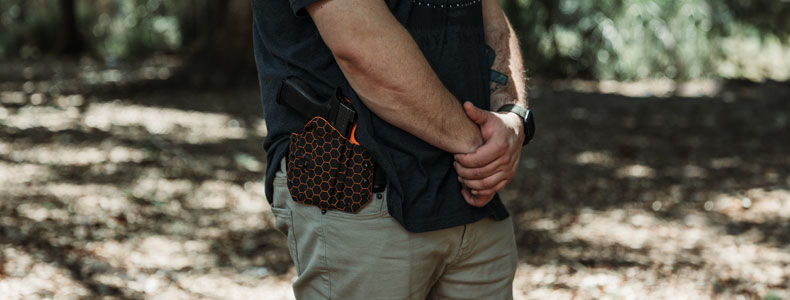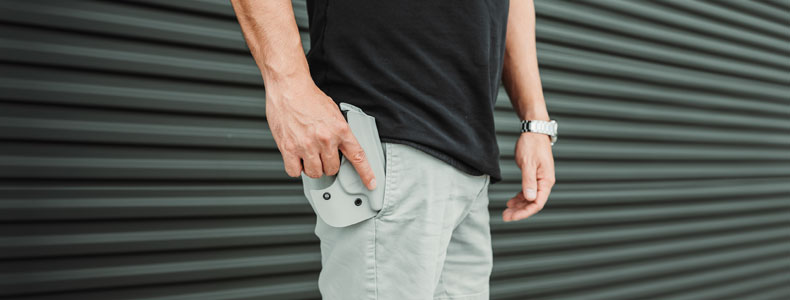How to Choose a Left Handed Holster

Left handed life is … different. The world was built for right handed folks, and the rest of us are left (pun intended) to make accommodations in order to get things done.
If you’re a left handed shooter, you’ve probably already gone through the process of finding a gun that works for you. And now, you’re looking for the right holster to pair with it.
As a left handed person, it’s crucial that you invest in a left handed holster compatible with your draw. Using a right handed holster in a left handed carry position, or trying to draw with your right hand as a leftie, is not only uncomfortable, but it can also be dangerous.
Keep scrolling for more information on what to look for in left handed concealed carry holsters.
Products Mentioned In This Article
Right Hand vs. Left Hand Holster: What’s the Difference?

So, what’s the difference between right and left handed holsters anyway? Aren’t they all the same?
It may come as a surprise to most shooters that the majority of holsters are actually right hand oriented. Left handed shooters, on the other hand, are painfully aware of this fact.
The difference between right and left hand holsters is simple: a right handed holster has a clip on the right side for IWB carry and the left side for OWB carry, while the clip on a left handed holster is the opposite, sporting a clip on the left side for IWB carry, and the right side for OWB carry.
These clip positions allow the user to place their holster in any carry position and reach it with their dominant hand. Using a holster that’s oriented for the wrong hand will make your draw slower, more awkward, and even potentially dangerous (more on that next!).
Why Use a Left Handed Gun Holster?

Besides the obvious benefit of easily reaching your weapon with your dominant hand, there are a few other reasons for choosing a holster designed for left hand use.
Convenience
Convenience is the most obvious reason to invest in a left hand holster. Using products designed for right handed people can be frustrating, and trying to smoothly draw a gun with your weak hand is nothing short of infuriating. A left handed holster is a much more comfortable and convenient choice for left hand draw.
Safety
When it comes to guns, safety should be your number one priority. Using a holster designed for your weak hand increases the potential for error, which, in the world of firearms, is very dangerous. As a leftie, drawing with your right hand may be a bit clumsy, especially in the heat of the moment. This raises the risk of flagging yourself or someone else or failing to draw in time, all of which can be deadly.
Speed
When faced with a situation where you need to draw your gun, every second counts. We don’t need to tell you that you’re faster with your dominant hand, even if only by a few moments. When you use a holster designed for lefties, the faster draw can make a huge difference in a self-defense encounter.
Accuracy
This one may surprise you. After all, once you’ve drawn your weapon and are ready to fire, what difference does your holster make? It’s simple. Most left handed people are also left eye dominant. When you draw from your right side, you will probably instinctively aim with your right eye at first, and your shot will be less accurate. Drawing from your left side, therefore, allows you to immediately aim with your left eye and produce a more precise shot.
How to Choose a Left Handed Holster

Like any other product, finding a holster designed for left handed people can be challenging. Here are a few considerations for a left hand holster:
Carry Position
Before you start to worry about your holster features, you should think about how you want to carry. The first thing to ask yourself is whether you want to carry inside the waistband, outside the waistband, or something else like off-body or pocket carry. That will help you determine the type of holster you need.
Next, you should decide which position you want to carry in. Do you want to carry appendix? Strong side? 7 o’clock? Depending on where you want to carry, you may want to invest in a different kind of holster. For example, while our ComfortTuck™ hybrid IWB holster works great for carrying in the 7-9 o’clock positions, if you’re looking to carry appendix or somewhere closer to the front of your body, you may want to try something a little smaller like our LightTuck™ IWB holster (though you can’t go wrong with this one in any position!).
Material
The next thing you should consider when looking for a new holster is the material you want. There are three main types of holsters: leather, nylon, and Kydex. All three are known for being comfortable, though it is generally not recommended to concealed carry with Nylon as it’s tough to reholster when carried IWB (it’s easily crushed by your waistband without your gun inside).
Leather is a popular holster choice and is known for being stylish and comfortable. The only issue that some people run into with leather is that it can become sticky when exposed to humidity, water, or sweat.
Kydex holsters are another popular choice. Despite being made from molded plastic, they are impressively comfortable and are easier to conceal, thanks to their slim design. Kydex holsters are crafted to precisely fit your specific gun model, making them an excellent, compact choice for concealed carry.
If you want the best of both worlds, a hybrid holster made with a Kydex shell and leather backing might be a good choice!
Adjustable
Adjustability is an important factor in any concealed carry holster, and this is especially true for lefties. When choosing a holster, you want to pick one that has adjustable ride height, retention, and cant, so you can ensure a comfortable, easy-to-draw carry in any position.
Because left handed shooters usually carry on their left side (obviously), situations like driving, where your left side is facing the car door, are a little more difficult to carry in. Having adjustable ride height and cant help make carrying easier by allowing you to position your weapon in an easy-to-access spot, no matter the circumstances.
Left Handed Carry Positions
Being left handed in no way limits the kind of carry positions you can use. The only difference between left and right hand carry positions is that they are opposite from one another!
When choosing a carry position that works for you, you’ll need to consider your body type, usual clothing choices, and lifestyle. Once you’ve settled on a position that you think will be a good fit, try it out for a few days to see how it works for you.
When discussing carry positions, we typically use the hours on a clock to refer to each different zone. To understand these positions, picture yourself standing on the face of a clock with your naval pointing to 12 o’clock, the small of your back facing 6 o’clock, and your hips at the 3 and 9 o’clock positions.

While there are several recommended carry positions, you can carry at any point that feels comfortable (yes, even at 4:25 or 2:50 o’clock!).
Here is a breakdown of the most common carry positions:
12 o’clock
The 12 o’clock position, right at your belly button, is a good option for anyone who carries a longer gun or just wants their weapon easily accessible at the front of their body. This is also a comfortable position for people who sit a lot throughout the day, and is known for being very easy to draw from.
Appendix Carry (10-11 o’clock)
Appendix carry, which is positioned at 10-11 o’clock for lefties, is easily one of the most popular carry positions there is, and rightfully so. Appendix carry is known for being comfortable for most people as well as easy to draw from (it is right at the front of your body, after all).
The only downside to appendix carry is that it may be difficult to conceal for certain body types and has the potential to dig into your groin or thigh while seated, which is not only uncomfortable but a safety hazard as well.
Strong-Side Carry (9 o’clock)
Strong-side carry, which is located at 9 o’clock, is one of the easiest positions to draw from. Because it is located directly on your hip bone, it can become uncomfortable after long periods and is pretty hard to conceal. If you’re open carrying, this position works great as your holster’s close proximity to your dominant hand will allow you to quickly draw your weapon if needed.
Kidney Carry (7-8 o’clock)
Kidney carry, or 7-8 o’clock for left-handed shooters, is another popular carry position. With kidney carry, your gun sits directly behind your hip in a fairly comfortable and easy-to-conceal spot. Drawing from this position can be a bit awkward if you’re not used to it, which is why larger pistols are not great for this one.
Small-of-Back (6-7 o’clock)
Small of back carry, otherwise known as the 6-7 o’clock area, is known for being comfortable and easy to conceal, though it has some major drawbacks.
Most experts discourage carrying in the small of the back position as it’s incredibly difficult to draw from, making you a sitting duck in a defensive situation AND effectively increasing your risk of muzzling yourself or someone else.
Not only that, but carrying 6 o’clock puts you at risk of serious injury due to the gun’s location right against your spine. If you were to fall or be pushed into something while carrying in this position, you could be seriously hurt or even paralyzed.
Cross Draw (1-3 o’clock)
Our final carry position is cross draw, or 1-3 o’clock. In this position, your weapon is secured on your weak side so you can draw will your dominant hand by reaching across your abdomen.
This position is relatively easy to conceal, though you do have to use extra caution when drawing so you don’t accidentally flag yourself or someone else in the process.
Where Can I Find Left Handed Holsters?

Because left handed people only make up about 10% of the population, finding holsters designed for left hand draw can be a bit of a challenge.
Sure, you can find some holsters designed for left hand draw at your local gun store or by doing a quick Google search. But finding a quality product is another story. Luckily, if you’re looking for a well-designed Kydex concealed carry holster for left handed people, you’ve come to the right place.
Here at Vedder Holsters, we offer a variety of Kydex and hybrid IWB and OWB holsters available in either left or right hand orientation. While most manufacturers only have a few select holsters designed for lefties, we offer our entire collection in left hand orientation.
Our left handed gun holsters are also designed with adjustable ride height, cant, and retention, so you can fine-tune your carry position exactly the way you need it. Left or right hand, we’re confident you can find something that will work great for you.
Check out our entire collection of holsters by visiting our gun holsters page or our holsters by gun model page.
Summary
Living life as a leftie can be challenging; finding a left handed holster doesn’t have to be.
As a left handed shooter, it’s important to invest in a holster that is specifically designed for your draw and carry positions. Trying to carry a holster made for right handed people as a leftie can be unsafe and uncomfortable. And besides, it’s just not necessary.
All of our holsters here at Vedder Holsters are available in a left hand orientation. We recommend visiting our Holsters by Gun Model page if you are looking for the best left handed concealed carry holsters that are custom-made for your weapon of choice. For all of our belt and holster options and for more information to help you choose the carry system that works best for you, visit our Vedder Holsters website.
Looking for items beyond holsters and belts, check out our Resources Page for popular product links like lights, lasers, first aid, maintenance, and more.




